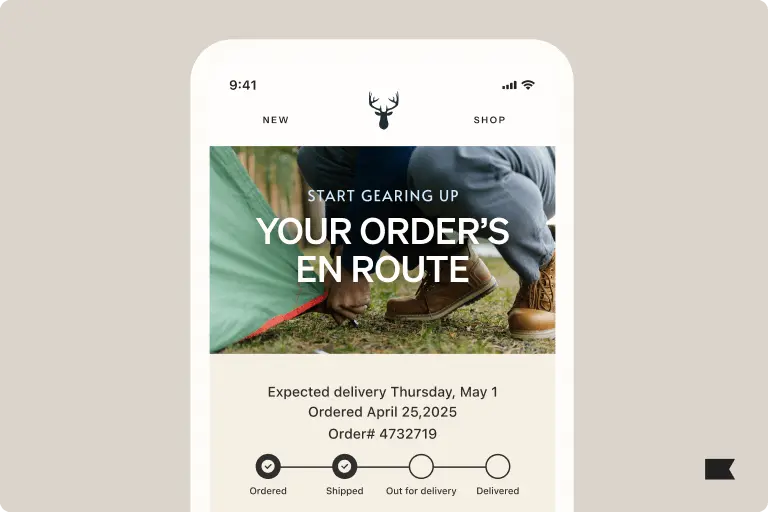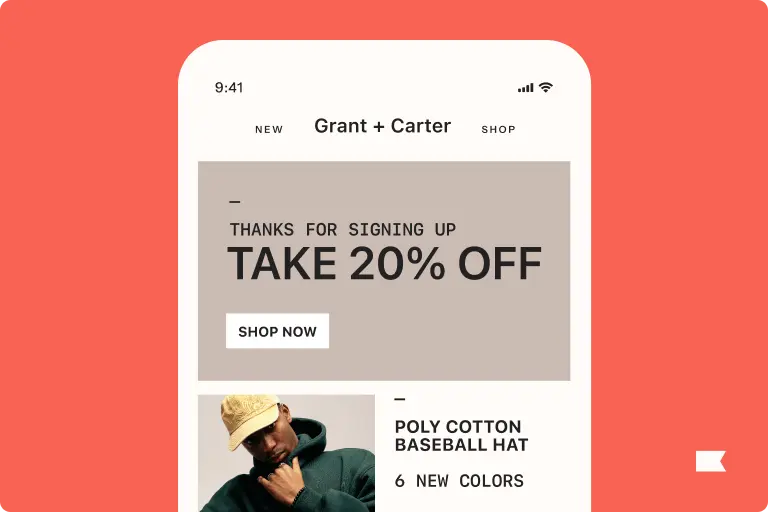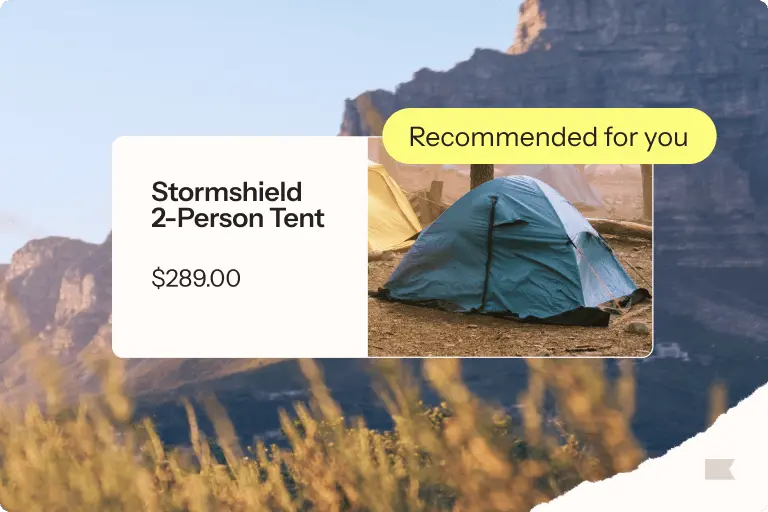What is an abandoned cart email? Their importance, function, and basic components
Abandoned carts are an inevitable part of running an ecommerce business.
More than 70% of online shopping carts are abandoned, according to a meta-analysis by the Baymard Institute.
That means no matter how attractive your store or how flawless your product, the majority of your customers will likely abandon their online shopping carts.
There are many reasons for this. Some of them are in your control—shipping fees, website errors—and some of them aren’t—readiness to buy, everyday distractions.
Here, we take you through the basics of the abandoned cart—why people don’t complete a purchase, the importance of abandoned cart emails, and how each component of these emails works to nudge people toward a sale.
What is an abandoned cart email?
An abandoned cart email is an automated email triggered when an online shopper places an item in their cart and doesn’t complete a purchase. It re-engages shoppers by reminding them about the products in their cart and enticing them to complete their purchase.
Customers often visit ecommerce businesses and browse products they like. But when they add a product to their cart, they demonstrate a desire to actually buy it, which reveals a high intent to purchase.
This is extremely valuable information for brands. When you know someone is close to buying, not only can you send them an abandoned cart flow—you can also place them in a highly engaged audience segment. If they don’t end up buying from your abandoned cart email, you’ll still know they’re close to buying, which means you can send them other offers and promotions down the line.
You can send one-off cart abandonment emails, or create a series of automated emails.
Abandoned cart emails and data privacy
A common misconception about abandoned cart emails is that they’re illegal and don’t comply with recent data privacy changes.
But instead of third-party data—consumer information you collect indirectly from a variety of sources, such as marketplaces and ad networks—abandoned cart emails use first-party data—online behavioral data you observe after someone gives you consent to contact them via email or SMS.
Marketing to customers using data you collect with their explicit consent, such as the information they offer up when they sign up to your mailing list, is legal and compliant with data privacy requirements.
Why do people abandon their shopping carts?
The meta-analysis by the Baymard Institute found that nearly 48% of shoppers ditch carts because they’re either “just browsing” or “not ready to buy.” But when they excluded this segment of people, Baymard also found that people don’t buy because:
Shipping and other fees are too high
Online shopping doesn’t jive well with the unexpected—and if shipping or other fees are too high, it’s a surprise that triggers extra consideration.
When high shipping and handling fees significantly increase the overall cost of an online purchase, customers may perceive the final price as too expensive compared to the product’s initial cost. This leads to hesitation, which oftentimes leads to cart abandonment.
To prevent this from happening, brands can offer free shipping thresholds or simply fold shipping costs into the price of the product. And if shipping costs are a big reason people are abandoning your carts, consider offering free shipping as an incentive in your abandoned cart email.
The online store asks them to create an account
We already have so many online profiles that we need password managers to account for them all. When you ask someone to create another account just to buy a product, you’re throwing up a major barrier to purchase.
Creating an account adds an additional layer of complexity and time to the check-out process, which can frustrate shoppers who are looking for a quick and seamless transaction. If you absolutely need to record an account for every purchase on your site, we recommend offering a guest check-out option so that customers can bypass account creation altogether.
If for some reason your product requires customers to create a personalized account for purchase, your abandoned cart email may need to offer a steep discount to make up for the requirement.
They don’t trust the website with their credit card information
Credit card scams are on the rise. According to the Motley Fool, there were 53% more reported cases of credit card fraud in 2023 than in 2019.
Many people are sensitive to this knowledge and are constantly on the lookout for scams that can compromise their credit card. If a website seems to lack security measures, like SSL certificates or trust badges, customers may feel their sensitive information is at risk, leading them to leave without completing their purchase.
To reduce this kind of cart abandonment, brands should:
- Ensure robust credit card encryption, such as requesting CVV number
- Display security certifications prominently
- Provide clear information on privacy policies and data handling practices
The product delivery estimate is too slow
Blame Amazon—people want their products fast. We’re not saying you need to offer same-day delivery to keep abandoned cart rates low, but your delivery estimates do need to be timely so more people complete their purchases.
A slow delivery estimate can outweigh someone’s immediate desire for the item—and as a result, shoppers will seek competitive alternatives that can deliver more quickly.
To prevent this from happening, offer a range of shipping options—including, most importantly, expedited services. Sometimes people are willing to pay more for faster delivery, and if they aren’t, you can offer those incentives for free in your abandoned cart email for high-value carts.
The returns policy isn’t satisfactory
Just like cart abandonment, returns are an inevitability of ecommerce. According to data gathered by Invesp, at least 30% of all products ordered online are returned, compared to 8.89% in brick-and-mortar stores.
But here’s why you should make that process as easy as possible. According to that same report, 92% of consumers would buy again from the same brand if the product return process were easy.
Before they even buy, people will abandon their carts in the face of an unclear or restrictive returns policy. Half the battle of persuading someone to buy from your brand is reassurance—and a lack of reassurance that people can return products easily leads to hesitation at check-out.
While your website should feature transparent language about your returns policy, your abandoned cart email can also reinforce a smooth process for returns if you’re seeing this as a large reason people abandon their carts.
There aren’t enough payment methods
If someone can’t find their preferred method of payment, they’re a lot more likely to abandon their purchase. Especially now, with so many convenient payment options—many of which don’t require much more than a CVV number entry and a click—it’s standard practice to offer a lot of convenient options.
According to Statista, the most popular payment methods in 2024 include PayPal (79%), Apple Pay (38%), Venmo (37%), Google Pay (31%), and Amazon Pay (30%):

Online retailers should integrate multiple payment solutions, including credit cards, digital wallets, and alternative payment methods, for a seamless and inclusive shopping experience.
Components of an effective abandoned cart email
Attention-grabbing subject line
The easiest way to grab customer attention is by personalizing subject lines using customer profile properties like their name, company name, or the products they left their cart.
Something as simple as “Hey Alex, where’d you go?” or “Stay hydrated with the bottles you left behind” can work wonders for your abandoned cart flow.
Product details
Product details about the item someone left behind should make up the bulk of your email copy. List key details like price, size, and color, and always include an image for the product.
Personalization
True personalization goes beyond featuring the recipient’s name and their specific abandoned items. Today, that’s table stakes.
With a data-first marketing platform like Klaviyo, you can take personalization to the next level by combining multiple data sources to create a hyper-relevant abandoned cart email experience. Personalize your incentives and offers based on factors like:
Offer incentives only for high-value carts
Include additional product recommendations based on the product pages someone’s viewed or the products they’ve purchased
Include their unique number or tier in the email and encourage them to use their rewards on their purchase
Exclude customers with open tickets from receiving an abandoned cart email
Call to action (CTA)
A clear and compelling CTA is what leads the recipient back to their cart on your website to complete the purchase. It should stand out with a distinct color and use action-oriented language, like “Complete Your Purchase” or “Return to Cart,” or maybe “Claim Your Offer” if you’re offering a good incentive.
Incentives and offers
Discounts, free shipping, or a limited-time offer are often the nudges a customer needs to go through with their purchase. Your incentives should address your brand’s most common barriers to completing a sale, like cost of the product or cost of shipping.
If it doesn’t make sense for your brand’s economics to offer an incentive for every abandoned cart, consider segmenting high-value carts and only offering an incentive on those where you stand to make more revenue from a single purchase.
Social proof
User-generated content in the form of customer testimonials, reviews, or ratings can build trust and get ahead of concerns. In addition to a solid product image with robust details, social proof is a great way to tip the scales toward a sale.
Urgency or scarcity
Urgency is a great way to persuade people to buy. Consider time-limiting your incentives by offering a personalized discount code, and include a countdown timer that shows when it expires.
Alternative product recommendations
If someone doesn’t complete a purchase, it may just be that they need to see alternatives before buying. Suggest related products, or showcase similar items other shoppers have bought, to provide a wider range of options.
Before you create your abandoned cart email flow, learn more abandoned cart email best practices so you’re getting the most out of them.
Set up an abandoned cart flow in minutes
One of the best things about abandoned cart flows is that they’re automated. That means when someone abandons a cart on your website, you don’t need to manually send an email.
In Klaviyo, a cart abandonment is considered an “event”, which triggers an email you set up beforehand with dynamic fields to personalize the experience for the shopper on the other end.
Learn how to set up an abandoned cart flow in Klaviyo with dynamic content blocks, time delays, templates, and even SMS.
Related content
- Anatomy of a flow: abandoned cart
- CurrentBody increases abandoned cart revenue by nearly 50% since implementing personalised customer journeys
- How to measure the success of your marketing automations—and then improve them



